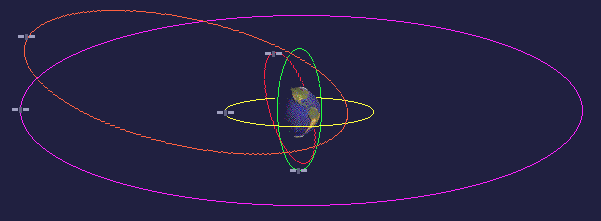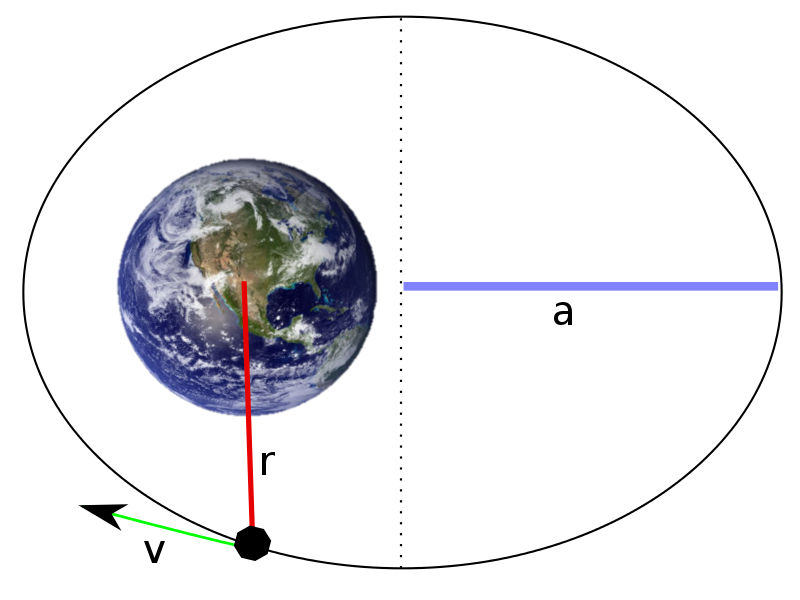In the history of science, vis viva (Latin for living force) is an obsolete scientific theory that served as an elementary and limited early formulation of the law of conservation of energy1. It was the first known description of what we now call kinetic energy2 or of energy related to sensible motions. Proposed by Gottfried Leibniz3 over the period 1676–1689, the theory was controversial as it seemed to oppose the theory of conservation of momentum4 advocated by Sir Isaac Newton5 and René Descartes6. The two theories are now understood to be complementary. Leibniz used the term living force to refer to the total kinetic energy of an isolated system7.
The theory was eventually absorbed into the modern theory of energy8 though the term still survives in the context of celestial mechanics through the vis-viva equation9: satellites make an elliptic orbit around the Earth according classic (Newtonian) astrodynamics.

The vis-viva equation relates the semi-major axis $$a$$ of the elliptic orbit, the distance $$r$$ between the satellite and the center of the Earth and the speed $$v$$ of the satellite relative to the Earth: \[ v^2 = \mu \left( \frac{2}{r} - \frac{1}{a} \right) \] The constant $$\mu$$ is the geocentric gravitational constant10. An approximation of this constant can be computed as the product of the gravitational constant11 $$G$$ and the mass $$M$$ of the Earth expressed in kilograms: \[ \mu = G \cdot M \] However, there are alternative methods to measure the value of $$\mu$$ with greater accuracy by observational astronomy alone. In this assignment we therefore use the more accurate value: \[ \mu = 398600{,}4418 \cdot 10^9\,m^3s^{-2}\] If the length of semi-major axis $$a$$ of the elliptic orbit is known, the period $$p$$ of the satellite can be determined (expressed in seconds): \[ p = 2\pi \sqrt{\frac{a^3}{\mu}}\] The period $$p$$ is the time it takes for the satellite to make a single orbit around the Earth.

Input
Two real-valued numbers, each on a separate line:
-
the distance $$r$$ between a satellite and the center of the Earth (expressed in meters)
-
the speed $$v$$ of the satellite relative to the Earth (expressed in meters/second)
Output
The given data can be used to compute the length $$a$$ of the semi-major axis of the elliptic orbit the satellite makes around the Earth. This can be done by rewriting the vis-viva equation: \[ a = \frac{\mu r}{2\mu - r v^2} \] The period $$p$$ of the satellite (expressed in seconds) can then be computed as \[ 2\pi \sqrt{\frac{a^3}{\mu}} \]
Three lines of output need to be generated:
-
the length $$a$$ of the semi-major axis of the elliptic orbit, expressed in meters
-
the length of the period $$p$$, expressed in seconds
-
the length of the period $$p$$, expressed as an integer number of days $$d$$, hours $$h$$ and minutes $$m$$ that completely fall within the period; make sure that $$0 \leq h < 24$$ and that $$0 \leq m < 60$$
Take a look at the examples given below to see how the output needs to be formatted.
Example
Satellite: the International Space Station (ISS12)
Input:
6792000
7658Output:
major axis: 6787166.808499204 meters
period: 5564.7257424392155 seconds
period: 0 days, 1 hours and 32 minutesExample
Satellite: ASTRA 1L13, a geostationary satellite which broadcasts BVN14 among other TV channels
Input:
35785400 3580.9
Output:
major axis: 42160215.133579694 meters
period: 86151.96905571753 seconds
period: 0 days, 23 hours and 55 minutesExample
Satellite: PROBA-215
Input:
7104000 7485
Output:
major axis: 7093371.63898765 meters
period: 5945.52283951033 seconds
period: 0 days, 1 hours and 39 minutesExample
Satellite: the Moon16
Input:
400000000 977.75
Output:
major axis: 384375790.60599077 meters
period: 2371619.541180138 seconds
period: 27 days, 10 hours and 46 minutes